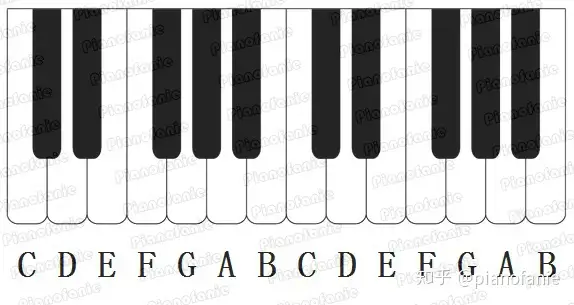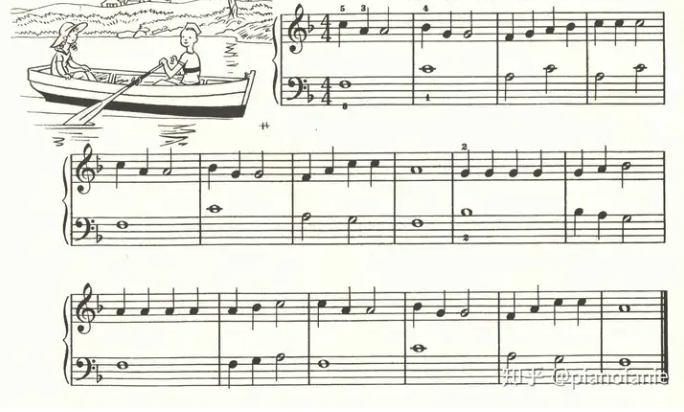Learning: What Are Movable Do and Fixed Do?
In music, there are seven notes, each corresponding to the solfège syllables: "Do, Re, Mi, Fa, So, La, Ti." The keyboard's keys have fixed letter names: "C, D, E, F, G, A, B" as shown below:

When sight-singing, if the piece is not in the key of C major, some students may feel like the notes they sing don’t match the sounds they hear. For example, in the below song, some students might sing directly according to the staff notation, vocalizing "Do La La, Ti So So..." while others might feel like they are singing "So Mi Mi, Fa Re Re..." This difference is due to the two different solfège systems: Fixed Do and Movable Do.

Fixed Do System
In the Fixed Do System, "Do" is always sung as the note C, regardless of the key. All other notes follow this pattern. For instance, D is always "Re," E is always "Mi," and so on. Even when the key changes, the note names remain the same.

Advantages of Fixed Do:
- This system is not dependent on the key, so you don’t need to know the key of the piece to sing it.
- The notes sung correspond exactly to the notes on the keyboard, making it easier to sing and play simultaneously.
- Staff notation uses the Fixed Do system, so it aligns well with traditional music reading.
However, one downside of the Fixed Do system is that it becomes challenging when there are many accidentals (sharps or flats), which can make it difficult for beginners to sing accurately without extensive practice.
According to the Fixed Do system, the piece mentioned earlier would be sung as "Do La La, Ti So So..."
Movable Do System
In the Movable Do System, the tonic (home note) of a major key is always sung as "Do." For example, in C major, C is "Do," while in G major, G becomes "Do," and in F major, F becomes "Do." As the key changes, the "Do" note shifts accordingly.
For instance, when 1 = G:

When 1 = F:

In minor keys, the tonic is sung as "La," and because minor keys are related to major keys by a minor third, the sung notes are actually the same as those in the relative major.
Advantages of Movable Do:
- It’s easier for beginners to sing in tune since the tonic is always "Do."
- The Movable Do system matches the way simplified notation (jianpu) works, making it easier to learn when using this notation.
The downside of Movable Do is that you need to determine the key before singing. If you misjudge the key, you may sing incorrectly. Additionally, for non-C major keys, the relationship between notes and the keyboard can become complex, as the location of "Do" changes for each key. For example, in G major, "Do" is G, while in F major, "Do" is F, making the playing process more complicated.
Using the Movable Do system, the piece mentioned earlier would be sung as "So Mi Mi, Fa Re Re..."
When playing from jianpu, you need to transpose according to the key signature. For instance, if 1 = G, you should transpose the jianpu to the key of G major.
Which Solfège System Is Better?
Debating which system is better is not very useful, as both systems are widely used. Pianofanie suggests using the system that aligns with the type of notation you have:
- For staff notation, use the Fixed Do system.
- For jianpu, use the Movable Do system.
This way, you are aligning your singing with the notation, making learning easier. If you feel like you’re not singing in the right key, don’t worry—just keep singing along with the piano to get the notes right, and you'll adjust in time.
Popular articles
- 1
Sheet Music: Hit Song - Piano Sheet Music - Free PDF - Kurousa-P - TSenbonzakura - PiaNoProblem
- 2
Sheet Music: Hit Song - Piano Sheet Music - Free PDF - Joe Hisaishi - One Summer's Day - PiaNoProblem
- 3
Sheet Music: Hit Song - Piano Sheet Music - Free PDF - William J. Ross - Carol of the Bells - PiaNoProblem
- 4
Sheet Music: Hit Song - Piano Sheet Music - Free PDF - Celine Dion - My Heart Will Go On - PiaNoProblem
- 5
Sheet Music: Hit Song - Piano Sheet Music - Free PDF - Frédéric Chopin - Waltz in A Minor - PiaNoProblem
- 6
Sheet Music: Hit Song - Piano Sheet Music - Free PDF - RADWIMPS - Kimi no Na wa (君の名は) - PiaNoProblem
- 7
Sheet Music: Hit Song - Piano Sheet Music - Free PDF - Joe Hisaishi - Merry Go Round of Life (Howl's Moving Castle) - PiaNoProblem
- 8
Share: Disney Animated Films That Won the Oscar for Best Original Song
- 9
Share: From Zero to Rock: Part Nineteen — The Velvet Underground
- 10
Sheet Music: Hit Song - Piano Sheet Music - Free PDF - Michael Giacchino - Disney Pixar: Up Theme Piano - PiaNoProblem
